VIA's Dual Core Nano & VN1000 Chipset Previewed
by Anand Lal Shimpi on November 15, 2010 12:26 PM ESTCPU Performance
Overall CPU performance is typically leaps and bounds better than Intel’s dual-core Atom D510. However that’s an easy target to beat. If we look at an identically (or even lower) clocked Pentium or Celeron dual-core processor, VIA loses.
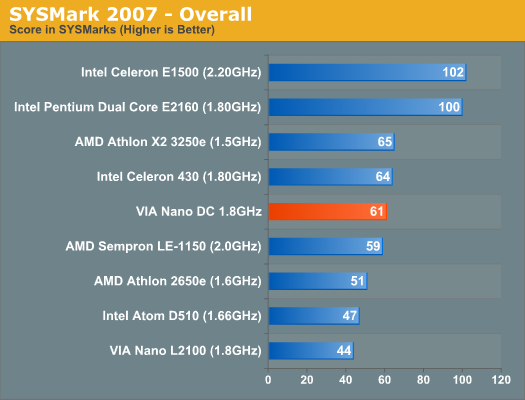
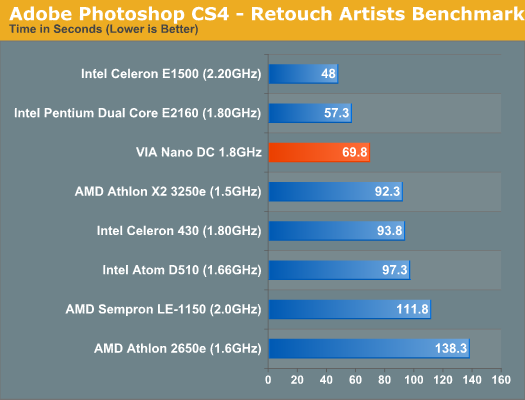
Photoshop performance is actually pretty impressive for the platform we're looking at. You get performance that's in the range of low end Pentium Dual-Core processors.
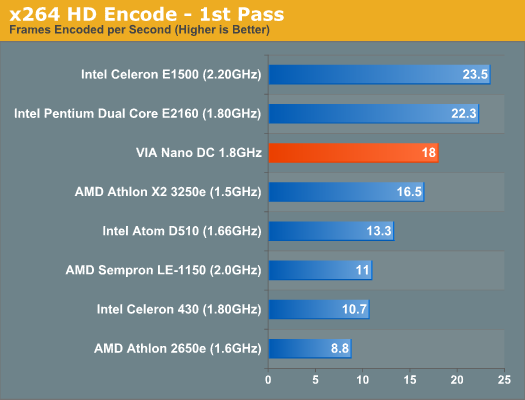
Even video encoding impresses as the DC Nano platform is faster than AMD's dual-core 1.5GHz Athlon X2. Intel has the performance-per-clock advantage with the Pentium dual-core but Atom is nowhere near it.
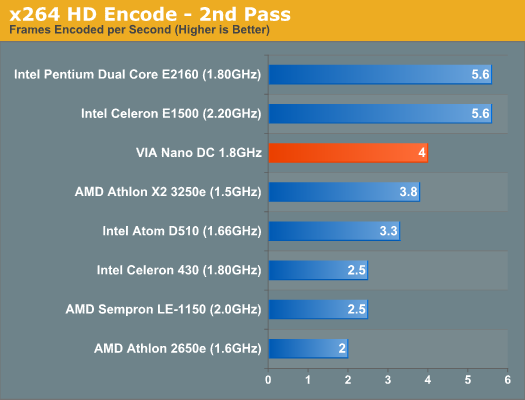
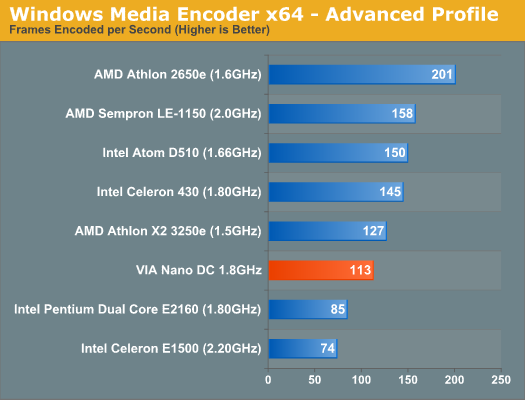
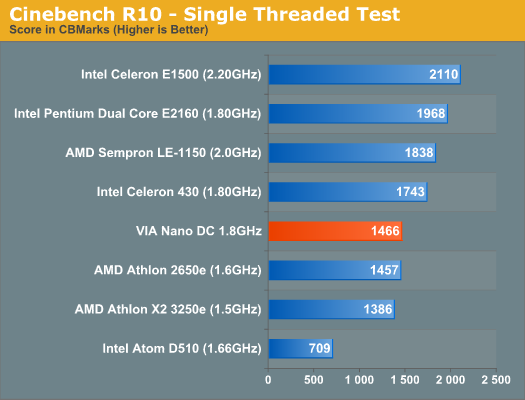
Nano's single threaded performance is really where it shines vs. Atom. You get roughly double the performance, which is quite visible in normal OS interaction or light apps like web browsing. Everything just pops up a lot quicker.
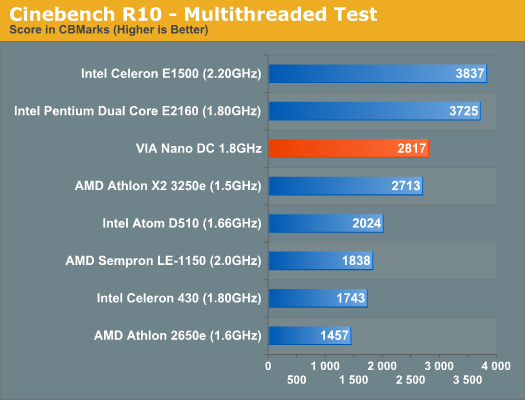
With a second core at its disposal the new Nano does very well in multithreaded environments as well. Again we have it besting the Athlon X2 3250e.
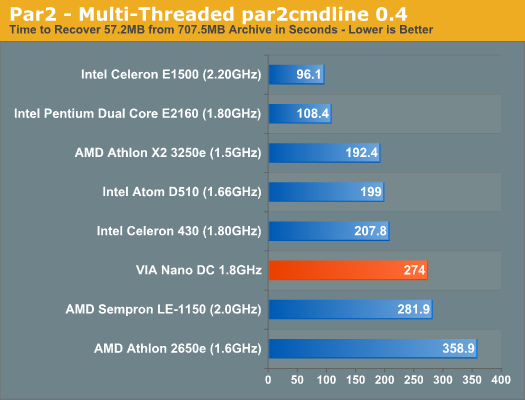
I ran our Par2 test here because it is highly optimized for Intel architectures. It is a real world test however and it shows you that despite VIA's architectural advantages, there will be situations where even an Atom may be faster.
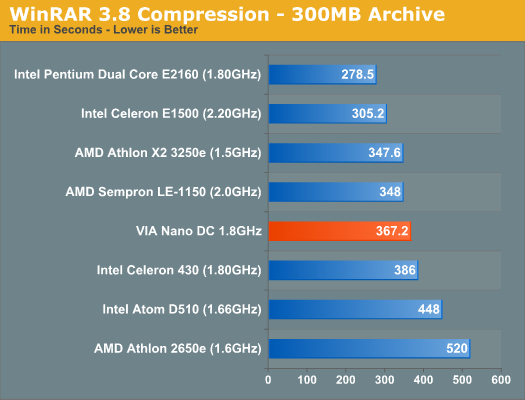
In most cases however, the DC Nano will be noticeably faster than a Pineview Atom and within striking distance of an Athlon X2.










54 Comments
View All Comments
Marlin1975 - Monday, November 15, 2010 - link
Why 65nm? Does TSMC only allow larger companies their 40nm?Why this, as you pointed out, over bobcat?
Yea VIA is still around but they will not be for long if they keep playing softbal like this. They need to take a big chance like AMD did with the orignal Athlon. Either come to win or be swept up by the bigger fish.
Mr Perfect - Monday, November 15, 2010 - link
The article says they're releasing 40nm in 2011, so this is probably just to tide them over.wazzap123 - Friday, November 19, 2010 - link
Yeah, there's a good analysis over at the daily circuit.http://www.dailycircuitry.com/2010/11/nano-duo.htm...
nafhan - Monday, November 15, 2010 - link
I think TSMC is pretty constrained on their 40nm node right now. Also, VIA probably had the design ready to go for 65nm.I agree with your "why would anyone buy this" sentiment, though. Bobcat seems to be aimed at almost the same market segment. Even though this seemed to work fine, between VIA and AMD, I'll trust AMD to deliver good drivers 10 times out of 10.
softdrinkviking - Tuesday, November 16, 2010 - link
If nano turns out to be less expensive than bobcat, I can totally see it's relevance.I'll never play a big game like MW2 on a small mobile platform anyway, so if nano and bobcat both load web pages and allow me to type documents at about the same speed, I'll buy the cheaper one.
FATCamaro - Monday, November 15, 2010 - link
From the days of the KT266 onwards they have been worthless. More power at idle and load than an i3 530. Good job!!!GeorgeH - Monday, November 15, 2010 - link
This is a pre-production 65nm sample VIA is using to give performance previews. The actual shipping product will be 40nm and have lower power consumptiion.Also, VIA made some good enough chipsets post KT266. Bang for your buck was often hard to beat - such as when VIA was one of the only ways to get a P4 with DDR SDRAM.
Goty - Monday, November 15, 2010 - link
I loved my old MSI KT3-Ultra motherboard running Via's KT333 chipset. I think it's still doing duty somewhere for my parents.juampavalverde - Monday, November 15, 2010 - link
Yupp! That MSI was a hell of a good board, i friend had one and sold it to another friend, its still alive and kicking with an overclocked throughbred.I had an Asrock KT600 board, the thing was the cheapest cr@pp around with sata those days, always was solid, with reasonable performance. Also still working (not at my home) with a barton, a couple of ddr gigs, and a radeon 9600, pushing win7 x86 nicely.
VIA didnt have a consistent platform for 478/775, but at amd chipsets (462,754,939) they did well in the agp times.
yuhong - Tuesday, November 16, 2010 - link
And I remember reading nForce4 being troublesome in the PCIe times. Did VIA gain from it?